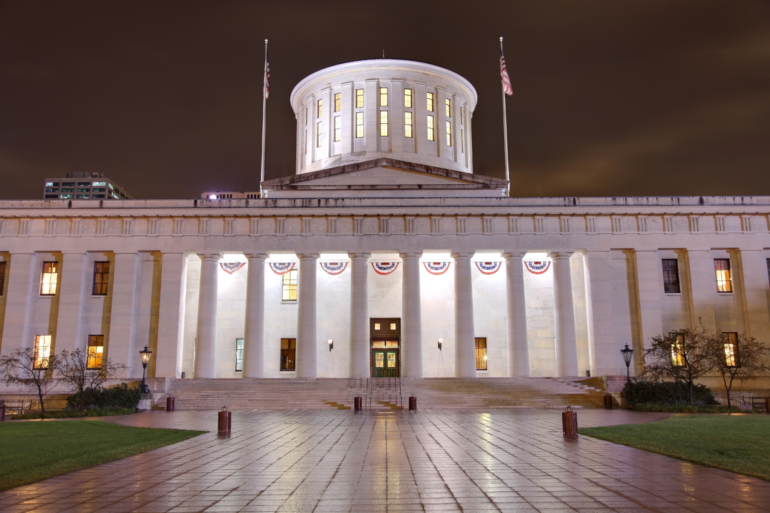This article was updated with an additional comment from Sherrod Brown.
Voters across the state will decide Issue 1, a proposed amendment to the Ohio Constitution.
Early voting starts July 11 at the Portage County Board of Elections, 449 S. Meridian St., Ravenna. On Aug. 8, Election Day, polls will be open from 6:30 a.m. to 7:30 p.m.
To vote early or in person, people will need one of the following: unexpired driver’s license or state I.D.; U.S. military, Ohio National Guard, or U.S. Department of Veterans Affairs I.D. card; or U.S. passport/card.
Absentee ballot applications are available at voteohio.gov and need to be sent to the elections board. Completed ballots must be returned in person to the board by 7:30 p.m. on Election Day or be postmarked no later than Aug. 7 and be received by the board no later than the fourth day after Election Day.
People voting by mail can use the last four digits of their Social Security number as a form of I.D.
What does Issue 1 propose?
In essence, Issue 1 seeks to make it more difficult for voters to propose and pass changes to the state constitution.
If Issue 1 passes, any proposed amendment to the state constitution would have to receive approval of at least 60% of eligible voters. A 50%-plus-one simple majority standard has been in place for more than a century.
It would also require that an initiative petition filed on or after Jan. 1, 2024, be signed by at least 5% of people in each of Ohio’s 88 counties who voted in the last gubernatorial election, instead of in only half of the counties.
If passed, Issue 1 would also prohibit additional signatures from being added to a petition initiative proposing to amend the state constitution that is filed with the Secretary of State on or after Jan. 1, 2024.
Currently, if groups do not collect enough signatures, Ohio law allows for a 10-day “cure period” during which amendment campaigns can try to collect more valid signatures in an effort to meet the required percentages.
Changes to the signature-gathering procedure would only apply to citizen-led initiatives. Amendments proposed by state lawmakers would have to be passed by a resolution with a three-fifths majority in the Ohio House and Senate.
If voters approve Issue 1, it would be effective immediately.
What do elected officials think about Issue 1?
Amanda Suffecool, chair of the Portage County Republican Party, said Issue 1 is meant to give all Ohioans a voice. She declined comment as to whether one county would be able to block the voices of the other 88 and also on the Issue 1 stipulation that would eliminate the “cure period” petition organizers currently enjoy.
Portage County Democratic Chair Denise Smith said Issue 1 would affect any proposed constitutional amendment.
“The legislators, the government, does not belong in personal decisions,” Smith said. “That’s my decision, my personal freedom. It’s not the legislators’ right to have a say in any of those personal issues. They should be paying attention to budgetary decisions, roads and bridges, and use of local government funds, use of our tax dollars.”
Supporting Issue 1, State Rep. Brian Stewart and State Sen. Rob McColley, both Republicans, sent a letter to Ohio Secretary of State Frank LaRose on May 22. They contend that Issue 1 would ensure that proposed amendments have widespread support, that special interest groups would no longer be able to “cherry pick” where they gather signatures, and that special interest groups would only have “one chance to play by the rules” as they gather their signatures.
Opposing Issue 1, state senators Paula Hicks-Hudson and Vernon Sykes and state representatives Dontavius Jerrells, Bride Rose Sweeney, and Dani Isaacsohn issued their own argument. According to the Democratic legislators, Issue 1 would mean 40% of voters could block any proposed constitutional amendment, effectively ending majority rule with regard to “any issue Ohioans will ever vote on.”
Approval of Issue 1 would also “permanently undo” constitutional protections that have been in place for over a century, and guarantee that “only wealthy special interests” instead of citizens could propose constitutional amendments, the legislators say.
Since Issue 1 would not affect laws placed on the ballot by citizens, it would not affect ongoing efforts to legalize recreational marijuana in Ohio.
It would, however, affect a current petition initiative affecting abortion access and other reproductive rights in Ohio.
On July 5, groups seeking to codify those rights in the Ohio Constitution submitted more than 700,000 petition signatures to LaRose’s office. If certified, the proposed ballot amendment would appear on the November ballot.
Despite having repeatedly stated that Issue 1 is not related to abortion, in June LaRose said, “It’s 100% about keeping a radical pro-abortion amendment out of our Constitution.”
That Issue 1 is timed to kick a possible constitutional amendment affecting abortion and reproductive rights off the November ballot is coincidence, Suffecool said.
LaRose’s comments linking Issue 1 to abortion access are his own, Suffecool said. For her part, she sees it as addressing multiple issues, including Second Amendment gun rights.
“The timing is whatever the timing is. There’s a spot where they have to draw a line in the sand,” Suffecool said. “It is not a single issue. It is not a single abortion, anti-abortion issue. It’s not, it’s bigger than that.”
U.S. Senator Sherrod Brown said in a statement: “Ohioans know what this is about: politicians trying to change the rules to go around voters and pass unpopular ideas like a total abortion ban. This comes down to whose side you’re on. I trust Ohioans and think they should have the final say – the corrupt politicians trying to shove this amendment through the legislature don’t.”
Wendy DiAlesandro is a former Record Publishing Co. reporter and contributing writer for The Portager.

